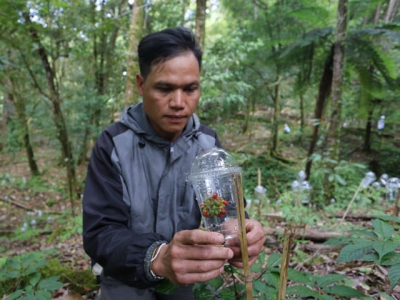Pest and disease preventive biological products boost Ngoc Linh ginseng to thrive

Beneficial microorganisms will be separated and selected to be used as materials in creating biological products to prevent pests and diseases on Ngoc Linh ginseng.
The use of biological products that have been studied and experimented with pest and disease prevention on Ngoc Linh ginseng will help the plants grow and develop well, with higher efficiency and productivity. Photo: L.K.
Ngoc Linh ginseng is a special medicinal plant of the high mountain areas on the Ngoc Linh mountain range. It was found in 1973 in the Ngoc Linh mountainous area of Dak To District, Kon Tum Province, and Nam Tra My District, Quang Nam Province.
According to experimental research by scientists, Ngoc Linh ginseng not only has typical pharmacological effects of the genus Ginseng, but also of other significant pharmaceutical functions such as anti-stress, anti-depression, immune system stimulation, and anti-inflammatory toxins that damage cells…
At a national conference on the development of Vietnamese herbal medicines, the Prime Minister emphasized that Ngoc Linh ginseng must be considered as a precious national treasure and it is necessary to preserve, develop and strengthen research as well as apply it to treatment and health care activities.
Ngoc Linh Ginseng is characterized by a slow growth under the canopy of wet forests and rich plant composition. Currently, natural ginseng has been gradually exhausted. Therefore, to meet the market and business demands, farmers have started to grow it in concentrated planting areas, with strict intervention and control.
In fact, in recent years, a number of researches on breeding techniques and farming methods have achieved certain success and effectively applied to production. This has contributed to the effective and sustainable development of ginseng ensuring suitable ecological conditions for its growth.
Despite that, only some researches on pest control have been done. Current prevention measures have not yet brought about desired results. Some plant protection drugs have been tested by farmers in preventing pests and diseases for seedlings in nurseries, but they are almost ineffective or have very low effectiveness.
With the aim to select and develop some measures to control pests and diseases for Ngoc Linh ginseng in a biological, effective, and sustainable direction as well as improve its yield and quality, the Institute Plant Protection in cooperation with Ngoc Linh Ginseng Development Center and Quang Nam Medicinal Materials has carried out a research project on the application of biological measures to control pests and diseases for Ngoc Linh ginseng in Quang Nam. The project is directed by Dr. Le Xuan Vi with the implementation period lasting from February 2019 to April 2021.
Accordingly, the project has determined the composition, biological characteristics, arising evolution, and assessment of the main pests and diseases’ harmful effects on Ngoc Linh ginseng. It has collected and selected 1-2 beneficial microorganisms in the growing area which have the potentials for producing and developing preventive probiotics products.
At the end of the implementation period, the project had identified 9 major pests and diseases on Ngoc Linh ginseng that can cause damage at both seedling and non-production stages. Among them, aphids (Neomyzus sp.), seedling death (P. glomerata), anthracnose (Colletotrichum acutatum), and rust (Pucinia sp.) are found the most common and dangerous diseases.
Along with determining the phylogenetic characteristics of these pests and diseases, the research team collected beneficial microbial strains and conducted some biological pest control experiments. The results showed that Bacillus subtilis and the antagonistic fungus Trichoderma sp. collected from ginseng growing areas have potentials for research and development of disease preventive biological products.
In particular, the project has developed a process for collecting, separating and selecting beneficial microorganisms. It has also created 10 liters of inoculant from Bacillus subtilis to serve for research and pilot implementation. The research team also conducted pest control experiments with probiotics.
Laboratory studies have been modeled on a scale of 2,000 plants, applying key pest control techniques. The effectiveness of aphid control is from 61.08% to 78.99%; Tree height in the model has increased from 0.1 - 0.8cm; The average number of seeds increased by 25.25%. The rate of infected plants and the rust index were significantly reduced.
Mr. Truong Cong Quang, Deputy Director of the Center for Development of Ngoc Linh Ginseng and Quang Nam Medicinal Materials, said that currently, the biological products made from the project are under the monopoly of the Plant Protection Institute, so the Center only applied in small scale areas to compare with others having not applied it.
Có thể bạn quan tâm
Phần mềm

Phối trộn thức ăn chăn nuôi

Pha dung dịch thủy canh

Định mức cho tôm ăn

Phối trộn phân bón NPK

Xác định tỷ lệ tôm sống

Chuyển đổi đơn vị phân bón

Xác định công suất sục khí

Chuyển đổi đơn vị tôm

Tính diện tích nhà kính

Tính thể tích ao hồ



 Quang Tri deploys model of raising organic pigs…
Quang Tri deploys model of raising organic pigs…  Bio-organic product helps recover citrus plants with yellow…
Bio-organic product helps recover citrus plants with yellow…